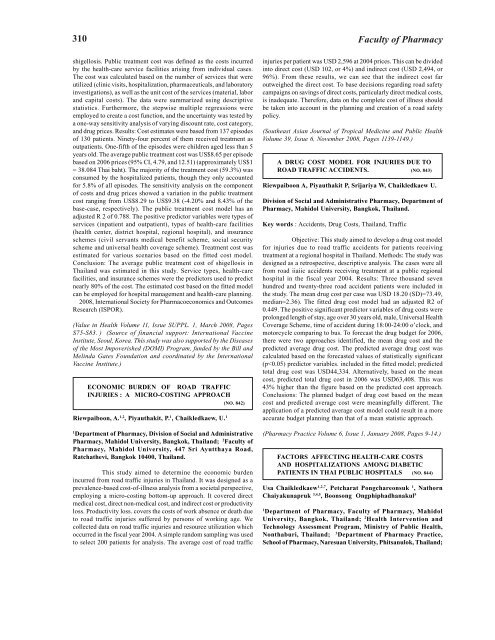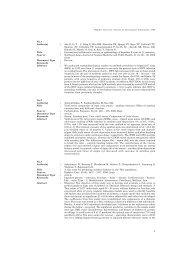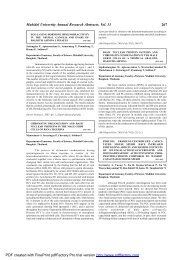Faculty of Pharmacy - Mahidol University
Faculty of Pharmacy - Mahidol University
Faculty of Pharmacy - Mahidol University
Create successful ePaper yourself
Turn your PDF publications into a flip-book with our unique Google optimized e-Paper software.
310 <strong>Faculty</strong> <strong>of</strong> <strong>Pharmacy</strong><br />
shigellosis. Public treatment cost was defined as the costs incurred<br />
by the health-care service facilities arising from individual cases.<br />
The cost was calculated based on the number <strong>of</strong> services that were<br />
utilized (clinic visits, hospitalization, pharmaceuticals, and laboratory<br />
investigations), as well as the unit cost <strong>of</strong> the services (material, labor<br />
and capital costs). The data were summarized using descriptive<br />
statistics. Furthermore, the stepwise multiple regressions were<br />
employed to create a cost function, and the uncertainty was tested by<br />
a one-way sensitivity analysis <strong>of</strong> varying discount rate, cost category,<br />
and drug prices. Results: Cost estimates were based from 137 episodes<br />
<strong>of</strong> 130 patients. Ninety-four percent <strong>of</strong> them received treatment as<br />
outpatients. One-fifth <strong>of</strong> the episodes were children aged less than 5<br />
years old. The average public treatment cost was US$8.65 per episode<br />
based on 2006 prices (95% CI, 4.79, and 12.51) (approximately US$1<br />
= 38.084 Thai baht). The majority <strong>of</strong> the treatment cost (59.3%) was<br />
consumed by the hospitalized patients, though they only accounted<br />
for 5.8% <strong>of</strong> all episodes. The sensitivity analysis on the component<br />
<strong>of</strong> costs and drug prices showed a variation in the public treatment<br />
cost ranging from US$8.29 to US$9.38 (-4.20% and 8.43% <strong>of</strong> the<br />
base-case, respectively). The public treatment cost model has an<br />
adjusted R 2 <strong>of</strong> 0.788. The positive predictor variables were types <strong>of</strong><br />
services (inpatient and outpatient), types <strong>of</strong> health-care facilities<br />
(health center, district hospital, regional hospital), and insurance<br />
schemes (civil servants medical benefit scheme, social security<br />
scheme and universal health coverage scheme). Treatment cost was<br />
estimated for various scenarios based on the fitted cost model.<br />
Conclusion: The average public treatment cost <strong>of</strong> shigellosis in<br />
Thailand was estimated in this study. Service types, health-care<br />
facilities, and insurance schemes were the predictors used to predict<br />
nearly 80% <strong>of</strong> the cost. The estimated cost based on the fitted model<br />
can be employed for hospital management and health-care planning.<br />
2008, International Society for Pharmacoeconomics and Outcomes<br />
Research (ISPOR).<br />
(Value in Health Volume 11, Issue SUPPL. 1, March 2008, Pages<br />
S75-S83. ) (Source <strong>of</strong> financial support: International Vaccine<br />
Institute, Seoul, Korea. This study was also supported by the Diseases<br />
<strong>of</strong> the Most Impoverished (DOMI) Program, funded by the Bill and<br />
Melinda Gates Foundation and coordinated by the International<br />
Vaccine Institute.)<br />
ECONOMIC BURDEN OF ROAD TRAFFIC<br />
INJURIES : A MICRO-COSTING APPROACH<br />
(NO. 842)<br />
Riewpaiboon, A. 1,2 , Piyauthakit, P. 1 , Chaikledkaew, U. 1<br />
1 Department <strong>of</strong> <strong>Pharmacy</strong>, Division <strong>of</strong> Social and Administrative<br />
<strong>Pharmacy</strong>, <strong>Mahidol</strong> <strong>University</strong>, Bangkok, Thailand; 2 <strong>Faculty</strong> <strong>of</strong><br />
<strong>Pharmacy</strong>, <strong>Mahidol</strong> <strong>University</strong>, 447 Sri Ayutthaya Road,<br />
Ratchathevi, Bangkok 10400, Thailand.<br />
This study aimed to determine the economic burden<br />
incurred from road traffic injuries in Thailand. It was designed as a<br />
prevalence-based cost-<strong>of</strong>-illness analysis from a societal perspective,<br />
employing a micro-costing bottom-up approach. It covered direct<br />
medical cost, direct non-medical cost, and indirect cost or productivity<br />
loss. Productivity loss. covers the costs <strong>of</strong> work absence or death due<br />
to road traffic injuries suffered by persons <strong>of</strong> working age. We<br />
collected data on road traffic injuries and resource utilization which<br />
occurred in the fiscal year 2004. A simple random sampling was used<br />
to select 200 patients for analysis. The average cost <strong>of</strong> road traffic<br />
injuries per patient was USD 2,596 at 2004 prices. This can be divided<br />
into direct cost (USD 102, or 4%) and indirect cost (USD 2,494, or<br />
96%). From these results, we can see that the indirect cost far<br />
outweighed the direct cost. To base decisions regarding road safety<br />
campaigns on savings <strong>of</strong> direct costs, particularly direct medical costs,<br />
is inadequate. Therefore, data on the complete cost <strong>of</strong> illness should<br />
be taken into account in the planning and creation <strong>of</strong> a road safety<br />
policy.<br />
(Southeast Asian Journal <strong>of</strong> Tropical Medicine and Public Health<br />
Volume 39, Issue 6, November 2008, Pages 1139-1149.)<br />
A DRUG COST MODEL FOR INJURIES DUE TO<br />
ROAD TRAFFIC ACCIDENTS. (NO. 843)<br />
Riewpaiboon A, Piyauthakit P, Srijariya W, Chaikledkaew U.<br />
Division <strong>of</strong> Social and Administrative <strong>Pharmacy</strong>, Department <strong>of</strong><br />
<strong>Pharmacy</strong>, <strong>Mahidol</strong> <strong>University</strong>, Bangkok, Thailand.<br />
Key words : Accidents, Drug Costs, Thailand, Traffic<br />
Objective: This study aimed to develop a drug cost model<br />
for injuries due to road traffic accidents for patients receiving<br />
treatment at a regional hospital in Thailand. Methods: The study was<br />
designed as a retrospective, descriptive analysis. The cases were all<br />
from road iiaiic accidents receiving treatment at a public regional<br />
hospital in the fiscal year 2004. Results: Three thousand seven<br />
hundred and twenty-three road accident patients were included in<br />
the study. The mean drug cost per case was USD 18.20 (SD)=73.49,<br />
median=2.36). The fitted drug cost model had an adjusted R2 <strong>of</strong><br />
0.449. The positive significant predictor variables <strong>of</strong> drug costs were<br />
prolonged length <strong>of</strong> stay, age over 30 years old, male, Universal Health<br />
Coverage Scheme, time <strong>of</strong> accident during 18:00-24:00 o’clock, and<br />
motorcycle comparing to bus. To forecast the drug budget for 2006,<br />
there were two approaches identified, the mean drug cost and the<br />
predicted average drug cost. The predicted average drug cost was<br />
calculated based on the forecasted values <strong>of</strong> statistically significant<br />
(p

















